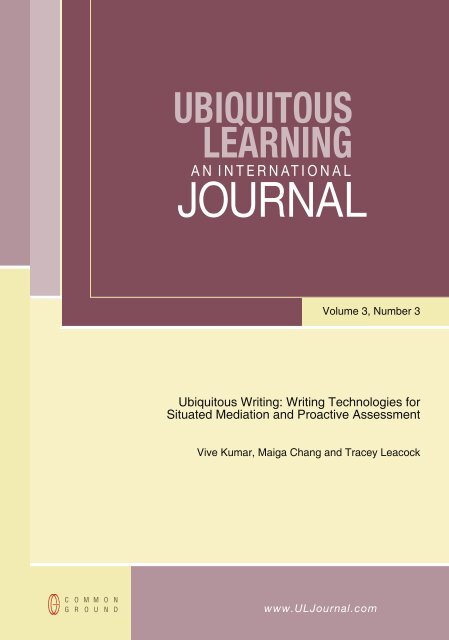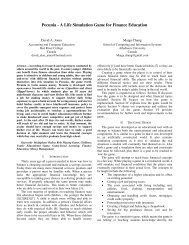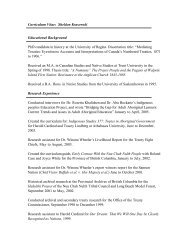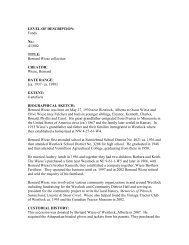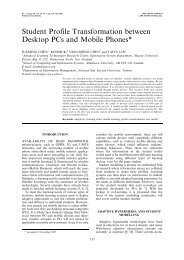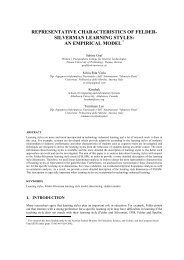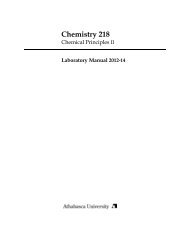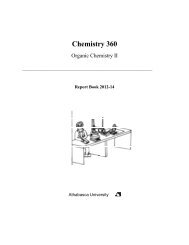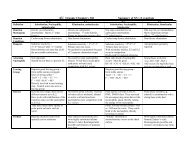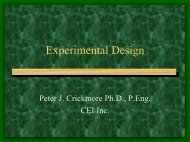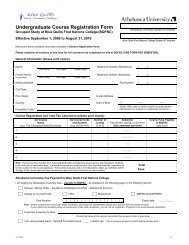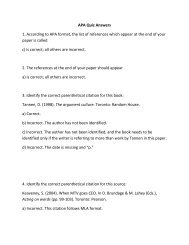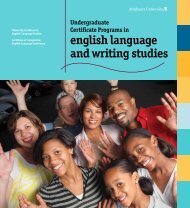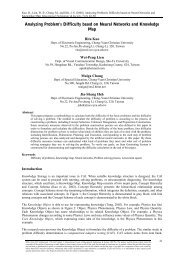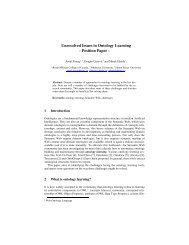JOURNAL - Dr. Maiga Chang - Athabasca University
JOURNAL - Dr. Maiga Chang - Athabasca University
JOURNAL - Dr. Maiga Chang - Athabasca University
Create successful ePaper yourself
Turn your PDF publications into a flip-book with our unique Google optimized e-Paper software.
UBIQUITOUS<br />
LEARNING<br />
A N I N T E R N AT I O N A L<br />
<strong>JOURNAL</strong><br />
Volume 3, Number 3<br />
Ubiquitous Writing: Writing Technologies for<br />
Situated Mediation and Proactive Assessment<br />
Vive Kumar, <strong>Maiga</strong> <strong>Chang</strong> and Tracey Leacock<br />
www.ULJournal.com
UBIQUITOUS LEARNING: AN INTERNATIONAL <strong>JOURNAL</strong><br />
http://ijq.cgpublisher.com/<br />
First published in 2011 in Champaign, Illinois, USA<br />
by Common Ground Publishing LLC<br />
www.CommonGroundPublishing.com<br />
ISSN: 1835-9795<br />
© 2011 (individual papers), the author(s)<br />
© 2011 (selection and editorial matter) Common Ground<br />
All rights reserved. Apart from fair dealing for the purposes of study, research, criticism<br />
or review as permitted under the applicable copyright legislation, no part of this work may<br />
be reproduced by any process without written permission from the publisher. For<br />
permissions and other inquiries, please contact<br />
.<br />
UBIQUITOUS LEARNING: AN INTERNATIONAL <strong>JOURNAL</strong> is peer-reviewed, supported<br />
by rigorous processes of criterion-referenced article ranking and qualitative commentary,<br />
ensuring that only intellectual work of the greatest substance and highest significance is<br />
published.<br />
Typeset in Common Ground Markup Language using CGPublisher multichannel<br />
typesetting system<br />
http://www.commongroundpublishing.com/software/
Ubiquitous Writing: Writing Technologies for Situated<br />
Mediation and Proactive Assessment<br />
Vive Kumar, <strong>Athabasca</strong> <strong>University</strong>, Edmonton, Canada<br />
<strong>Maiga</strong> <strong>Chang</strong>, <strong>Athabasca</strong> <strong>University</strong>, Edmonton, Canada<br />
Tracey Leacock, Simon Fraser <strong>University</strong>, Burnaby, Canada<br />
Abstract: Writing is a core skill students are expected to develop early in their schooling. However,<br />
tracking and understanding the development of learners’ expertise in writing poses considerable<br />
challenges, given the complexity of the writing process and the volume of data. This paper discusses<br />
two technologically-enhanced pedagogical methods that hold the potential to enhance writing competence.<br />
The first method uses a situated learning activity involving the use of cellular phones to assist<br />
mobile learners. The second method tracks learners’ activities as they complete a writing exercise<br />
using a special mixed-initiative editor called MI-Writer. Preliminary results from two studies, one<br />
conducted in Taiwan involving a mobile learning treasure hunt, and the second conducted in New<br />
Zealand provide insight into possible uses of these pedagogical approaches to support mobile student<br />
writers. We use the results of the studies to emphasize the need for ubiquitous, situated, mixed-initiative<br />
writing support for students. We present an overview of the technology behind these two platforms<br />
and discuss their real-world applicability based on experimental studies. These technology platforms<br />
could be extended to measure individual competencies, identify writing competency-gaps, and promote<br />
means to address these gaps.<br />
Keywords: Ubiquitous Writing, Situated Writing, Mixed-Initiative Interactions, Mobile Technologies,<br />
Model Tracing<br />
Introduction<br />
BEYOND THE FIRST few years in school, learners are expected to be able to write<br />
effectively across a wide range of disciplines and genres, yet learners seem to have<br />
difficulty achieving such a level of mastery (Ball, 2006; Korbel, 2001; Salahu-Din,<br />
Persky, & Miller, 2008). Despite this mismatch between expectations and observations,<br />
effective writing skills continue to be important in school, in the workplace, and, increasingly,<br />
in purely social contexts. To address this gap, many schools and universities<br />
have developed specialized interventions to help improve academic writing skills. These<br />
range from providing writing support from peer or professional tutors or reviewers (e.g.,<br />
Cho & Schunn, 2007; Nelson & Schunn, 2009), to providing explicit strategy instruction<br />
(e.g., Boscolo, Arfé, & Quarisa, 2007; Graham, 2006; Wallace et al., 1996), to requiring all<br />
students to take a single course focused on the basics of writing (see Carroll, 2002 for a critique<br />
of this approach), to integrating writing-intensive courses into the disciplines so students<br />
have multiple exposures to writing for different academic purposes (e.g., Burk, 2006; Defazio,<br />
Jones, Tennant, & Hook, 2010). However, given the volume of data generated, it can be<br />
difficult to assess the impact of such interventions (Duke & Sanchez, 2001; Melzer, 2009).<br />
Ubiquitous Learning: An International Journal<br />
Volume 3, Number 3, 2011, http://ijq.cgpublisher.com/, ISSN 1835-9795<br />
© Common Ground, Vive Kumar, <strong>Maiga</strong> <strong>Chang</strong>, Tracey Leacock, All Rights Reserved, Permissions:<br />
cg-support@commongroundpublishing.com
UBIQUITOUS LEARNING: AN INTERNATIONAL <strong>JOURNAL</strong><br />
Advances in technology may be able to help both with the task of helping learners to become<br />
better writers and with the goal of collecting and analyzing data on the impact of writing<br />
interventions on academic writing.<br />
Writing Processes<br />
Writing is a goal-directed activity that involves a range of interlinked cognitive processes<br />
(Flower & Hayes, 1981). In their seminal 1980 paper, Hayes and Flower (see also Hayes,<br />
1996) introduced a cognitive process model of writing that acknowledged the complexity<br />
and recursion involved in the writing process. Hayes and Flower described writing as involving<br />
three major cognitive processes – planning, translating, and reviewing – and several<br />
sub-processes, each of which may come into play throughout the writing activity. Skilled<br />
writers often switch back and forth across all three major processes as they build and refine<br />
their texts. This natural switching complicates attempts to study writing by making it difficult<br />
to isolate individual processes. In this chapter, we provide a brief introduction to writing<br />
processes based on Hayes and Flower’s model and discuss how technology-enhanced approaches<br />
to writing instruction may help both writing researchers and student writers.<br />
Planning<br />
In writing, planning involves setting goals, generating ideas, and organizing those ideas to<br />
fit the goals. Winne and other self-regulated learning researchers have noted the centrality<br />
of goal definition in all learning tasks (Leacock, Winne, Kumar, & Shakya, 2006; Winne,<br />
2001). The instructor typically provides some goal-related information as part of the assignment,<br />
but learners will use their own understanding of this information, along with cues from<br />
other external sources, such as peers, reference documents, or authentic contexts in which<br />
a particular learning activity may be taking place (e.g., a treasure hunt), to guide the generation<br />
of ideas (Klein & Leacock, in press). Thus, one way technology may help student writers is<br />
by assisting them to align their writing goals with those intended by their instructor so that<br />
the ideas they generate will be on-topic (Hadwin, Winne, Nesbit, & Kumar, 2005; Venkatesh,<br />
Wozney, & Hadwin, 2003; Zhou & Winne, 2009).<br />
The organizing sub-process can take many forms. In some cases, the writer may be able<br />
to organize the ideas in his or her head, but more often in school-based writing, learners are<br />
asked to organize their ideas on paper or on screen via notes, outlines, or other pre-writing<br />
activities. Using such external artefacts can help writers manage the cognitive load associated<br />
with both holding multiple ideas in mind and experimenting with different organizational<br />
structures. Prior knowledge can also affect students’ ability to generate ideas and organize<br />
them (DeGroff, 1987). Because students are typically asked to write about topics in which<br />
they don’t yet have expertise, advances in technology have the potential to assist writers<br />
both by supplementing limited prior knowledge and by easing the working memory load<br />
associated with reorganizing ideas and comparing different structures (Winne, 2001; 2006).<br />
Finally, helping writers to identify when they should revisit their writing plan is yet another<br />
way that technology may be able to enhance student writing (e.g., Zellermayer, Salomon,<br />
Globerson, & Givon, 1991).<br />
174
VIVE KUMAR, MAIGA CHANG, TRACEY LEACOCK<br />
Translating<br />
Flower and Hayes define translating as “putting ideas into visible language” (p. 373; 1981).<br />
Whether writers use pen and paper, laptop computers, or mobile devices, translating involves<br />
taking the ideas in one’s head and the collection of notes or other outputs from the planning<br />
process and turning them into formal text. A number of technology solutions, such as automatic<br />
spelling and grammar checkers, are already widely available to help students produce<br />
correct orthography and syntax, and some researchers have also proposed tools to help students<br />
make better diction choices (e.g., Hayes & Bajzek, 2007). Additional technological<br />
supports that help students translate their ideas into language appropriate for a specific assignment<br />
hold the potential to improve student writing.<br />
Reviewing<br />
The importance of review processes is often underestimated by student writers, who see it<br />
as involving either the correction of minor surface level features, such as typos, or as evidence<br />
that the writer has done something very wrong and has to “start from scratch again” (Leacock,<br />
2007). Yet, the majority of reviewing activities fall somewhere between these two extremes<br />
(Flower, Hayes, Carey, Schriver, & Stratman, 1986; Gilmore, 2007; Hayes, 2004). Reviewing<br />
involves three sub-processes: reading, evaluating, and revising (Flower & Hayes, 1981;<br />
Hayes, 1996).<br />
Reading<br />
For competent readers, reading one’s own text for meaning is relatively easy; however, attending<br />
closely enough to the actual text (rather than the intended meaning) to identify errors<br />
is more difficult. Writing guides often recommend that students have a peer read the text<br />
out loud to the writer instead, and there is some evidence that this leads to more effective<br />
reviewing (Scarcella, 2003). Technologies that can read the text-so-far out loud may be one<br />
means of supporting the review process (e.g., see Raskind & Higgins, 1995 for a study of<br />
college students with reading disabilities who used text-to-speech software).<br />
Evaluating<br />
Evaluating involves comparing the text-so-far with the writing goals at both local and global<br />
levels, making evaluation a high-load process. Technologies that can scaffold writers through<br />
systematic evaluation processes may help writers to correctly locate and identify problems<br />
with their text. Technologies can also support logistical challenges involved in peer evaluation.<br />
For example, the Scaffolded Writing and Reviewing in the Discipline software (SWoRD;<br />
Cho & Schunn, 2007), provides a system both for distributing/returning peer reviews and<br />
for calculating and assigning grades to writers (based on multiple peer reviews) and reviewers<br />
(based on evaluations completed by the writers).<br />
Revising<br />
Once students have located a problem in their text, identified the type of problem, and decided<br />
to take action to repair it, they still may lack the requisite knowledge and skills to make an<br />
175
UBIQUITOUS LEARNING: AN INTERNATIONAL <strong>JOURNAL</strong><br />
effective repair (Winne, 2001). Technologies that help to guide students or provide possible<br />
solution approaches may help students make better revision decisions (Cho, Chung, King,<br />
& Schunn, 2008).<br />
The evaluating and revising sub-processes, in particular, create high cognitive load for<br />
student writers, and tools that would help students to minimize or automate portions of this<br />
load are likely to assist learners in becoming better writers. The Concept Revision Tool,<br />
which analyses student texts and prompts them to reflect on specific concepts within their<br />
texts is an example of a technology designed to help students with the process of reviewing<br />
(Jucks, Bromme, & Schulte- Löbbert, 2007).<br />
Writing Contexts<br />
In addition to drawing on a range of cognitive processes and resources, writing activities<br />
also take place within a given context. The typical in-school writing assignment requires<br />
learners to work independently and submit their text to a one-person expert audience – the<br />
teacher. With the influx of technology to both the classroom and daily life, the social context<br />
of academic writing is changing rapidly. Now, students frequently collaborate with peers<br />
across all writing processes, and written work may be published to the whole class or even<br />
to more public audiences through the use of social media technologies (Cho & Schunn, 2007;<br />
Cummings and Barton, 2008; Warschauer & Ware, 2008). As learners become more used<br />
to writing collaboratively for real audiences, there is great potential to use technologies designed<br />
to facilitate collaboration and the sharing of information as tools to help students<br />
improve their writing.<br />
The remaining sections of this chapter present two preliminary studies that provide insight<br />
into ways that new technologies may be harnessed to enhance writing competence. This review<br />
mostly addresses writing processes concerning adult writers. These two studies however<br />
attempt to engage high school students in some of these processes.<br />
Study 1: Mobile Treasure Hunting<br />
Initially, the use of mobile devices in instructional settings was tentative, but there have now<br />
been numerous K-12 projects that have integrated cellular phones into a variety of authentic<br />
instructional contexts with powerful results (Horkoff & Kayes, 2008; Keegan, 2002;<br />
Tremblay, 2010). (See also http://k12cellphoneprojects.wikispaces.com/ for examples posted<br />
by teachers.) Instructors are increasingly also recognizing the benefits of situated learning<br />
(Anderson, Reder, & Simon, 1996), and one popular approach to situated learning is the<br />
treasure hunt (<strong>Chang</strong> & <strong>Chang</strong>, 2006; Wu, <strong>Chang</strong>, <strong>Chang</strong>, Yen, & Heh, 2010). The current<br />
study investigated the use of cell phones to augment a treasure hunt learning activity in which<br />
students used the phones to aid them in locating historical and cultural artefacts in the city<br />
that had been tagged with QR-codes.<br />
The Mobile Treasure Hunt as a Pedagogical Model<br />
Figure 1 shows the mobile treasure hunting model used in the study. This model has two<br />
phases: the prior knowledge assessment phase and the hunting phase. Assessment can be<br />
achieved with traditional paper-pencil tests, through computerized tests, or a mix of tradi-<br />
176
VIVE KUMAR, MAIGA CHANG, TRACEY LEACOCK<br />
tional and online methods. The system determines the initial knowledge level of the student<br />
(step 1 in Figure 1) based on the data from these assessments and uses this to characterize<br />
the student’s knowledge structure. The system then uses these results and the current location<br />
of the student to generate a customized quest for relevant artefacts tagged with QR-codes<br />
in the immediate vicinity of the student (steps 2 and 3 in Figure 1). Once the system has<br />
generated the quest, it sends the quest and the relevant guidance to the student’s cell phone<br />
via Short Message Service (SMS; step 4 in Figure 1).<br />
Figure 1: Treasure Hunting Architecture<br />
Figure 2: A Sub-goal of a Treasure<br />
Hunt Quest<br />
Each quest consists of a puzzle that the student must solve to identify the intended destination.<br />
For example, the quest may mention the symptoms of a disease and that the chief of an ancient<br />
village is looking for medicinal plants known to cure the disease. This requires the treasure<br />
hunter to identify the disease before searching for the plants. When the treasure hunter finds<br />
something relevant, s/he can use the built-in camera to take a picture of the QR-code attached<br />
to the artefact (step 5 and step 6 in Figure 1). Some quests may ask the student to observe a<br />
phenomenon to answer a question and to then text the answer back to the system (step 6 in<br />
Figure 1). The system validates the student’s answer by interpreting the QR-code or text<br />
(step 7 in Figure 1). If the answer is validated, the system will proceed to offer another puzzle<br />
(i.e., quest) for the student. This process continues until the final treasure, a virtual box<br />
containing gold and weapons/armour, has been found.<br />
The components of a quest are like jigsaw pieces (see Figure 2). The background information,<br />
puzzle description, clues, and quest elements of the story all fit together to enable the<br />
student to complete the puzzle. Each piece also corresponds with a number of sub-goals of<br />
the story, which itself is like a larger jigsaw puzzle. Students are required to solve the subgoals<br />
in a prescribed sequence/order to receive next piece.<br />
177
UBIQUITOUS LEARNING: AN INTERNATIONAL <strong>JOURNAL</strong><br />
Methods<br />
This preliminary study was conducted with 18 participants (all 11 years old) from a grade<br />
5 class at an elementary school in Tainan, Taiwan. Each student was given a Nokia 5800<br />
mobile phone with built-in GPS, camera, touch screen, Bluetooth functionality, and running<br />
the Symbian operating system. GPS signals were used to determine the general location of<br />
each student, and information on the most recent QR-code scanned was used to determine<br />
more precise locations.<br />
The quests were built around the historical and cultural artefacts of the Five-Harbor District.<br />
A total of 12 artefacts were spread across the five areas in the District. The treasure hunt<br />
was designed to last two to three hours, with the goal of introducing 5 artefacts situated in<br />
three different areas to each student. Each student’s prior knowledge assessment was used<br />
in determining the five artefacts that student would look for. A key goal of the exercise was<br />
to enable students to study the selected artefacts in their authentic historical contexts (see<br />
Figure 3).<br />
Figure 3: Some Artefacts were Located in<br />
the Medicine King Temple<br />
Figure 4: Scanning a QR- code using the<br />
Phone<br />
Students were asked to complete three tasks for each artefact. The first task for the student<br />
was to use the QR-code to verify whether the artefact was adjacent to a targeted historical<br />
building (see Figure 4). The second task was to travel to a specific location to identify a<br />
particular relic as instructed by a pop-up message on the cell phone screen. For the third<br />
task, the student had to discover specific information found in the area of the relic in response<br />
to a question sent via the cell phone and send their answer back to the instructor for evaluation.<br />
At the end of each treasure hunting field trip, “students were interviewed completed a<br />
questionnaire” that asked them about whether:<br />
• They liked the treasure hunting activities<br />
• They preferred learning outside the classroom or inside the classroom<br />
• The mobile phone interface was easy to use during the treasure hunting trip<br />
178
VIVE KUMAR, MAIGA CHANG, TRACEY LEACOCK<br />
Results and Discussion<br />
This study investigated two key questions: whether students liked the notion of a treasure<br />
hunt as part of their educational field trips and whether students who preferred outdoor<br />
activities had higher motivation in treasure hunting than students who preferred indoor<br />
activities. Out of the 18 participants, 16 were positive about their treasure hunting experiences<br />
on the questionnaire; the video-taped interviews confirmed this finding. The results also<br />
showed that mobile and situated learning activities made students excited about their learning<br />
environment, particularly students who were already outdoor-inclined.<br />
Mobile devices and applications are becoming ubiquitous, yet they are under-used in<br />
educational contexts. The study reported here shows how mobile devices can be used to take<br />
learning outside the confines of the classroom into authentic contexts.<br />
During treasure hunting activities students actually role-play an actor in the story of the<br />
virtual world. They interact with virtual people in the virtual world and touch/observe objects<br />
in the real world. The interlacing of interactions between these two worlds establishes the<br />
learning context. For instance, students can accompany Alexander the Great in the virtual<br />
city of Alexandria and listen to his whispers and plans for real. These experiences motivate<br />
and help students establish the context for writing.<br />
As a next step, we intend to extend the current mobile device treasure hunting activity<br />
with targeted writing tasks that encourage students to write about relevant features of their<br />
surroundings. Although the small screens of mobile devices may not at first seem conducive<br />
to academic writing, there is clear evidence from pop culture that users of these devices may<br />
have other ideas about appropriate use. For example, the cell phone novel is now a cultural<br />
phenomenon in Japan (Onishi, 2008). This does not mean that cell phones will replace other<br />
tools of writing, but it does show they may be viable options as supplementary academic<br />
writing tools. Students can use cell phones to take on-site notes, keep a record of route information,<br />
etc. during their field trip; these records can later be used to help generate and<br />
organize ideas to create a written report on what the student has learned. Taking advantage<br />
of the tools that students already use to help introduce them to the concepts and techniques<br />
of formal writing has the potential to increase student interest in academic writing.<br />
Study 2: A Writing Interface with Mixed Initiatives<br />
A mixed-initiative system is one that gathers data on a learner’s interaction with the system,<br />
creates statistical and heuristic inferences, and uses these inferences to proactively offer<br />
feedback to the learner at instructionally opportune times (Allen, 1999; Guinn, 1999). In<br />
addition to traditional academic performance data, mixed-initiative systems collect a range<br />
of learning-process data that is not easily observed or recorded by the instructor. For example,<br />
in the context of writing, such learning-process data may include information on when<br />
learners correct grammar, modify complex sentences, split larger paragraphs into smaller<br />
ones, and attempt to revise vocabulary.<br />
Most intermediate schools in New Zealand offer well-defined writing models (see http://www.tki.org.nz/r/assessment/exemplars/eng/<br />
for sample models of writing) to their students.<br />
However, it is extremely time consuming for teachers to monitor student writing habits<br />
and provide formative feedback to students as they learn to write using these prescribed<br />
models (Duke & Sanchez, 2001). In general, it becomes hard for teachers to extract useful<br />
179
UBIQUITOUS LEARNING: AN INTERNATIONAL <strong>JOURNAL</strong><br />
information from the reporting tools of online learning platforms when there are a great<br />
number of students (<strong>Dr</strong>ingus & Ellis, 2005), and teachers are more likely to provide summative<br />
assessments only. In an effort to support teachers in their attempts to provide both<br />
formative and summative feedback to students, we developed the MI-Writer system – educational<br />
software that tracks the writing processes and the development of writing skills of<br />
students, with respect to prescribed writing models, as they undertake specific writing exercises.<br />
The software enables teachers to focus on an individual’s writing skill development<br />
as well as observe emergent patterns of writing habits for the entire class. Further, the software<br />
can provide model-specific feedback to students, as prescribed by the teacher.<br />
A preliminary study was conducted to test the applicability of a mixed-initiative writing<br />
system in an authentic grade 5-7 classroom setting, where students engaged in a letter-writing<br />
exercise over a period of three months. Students used MI-Writer to prepare an outline and<br />
then to develop the outline into a full letter; MI-Writer captured the activities of individual<br />
students as they worked. During the exercise, the teachers modelled formative writing<br />
activities, such brainstorming, self-reflection, concept mapping, and intermediate peer<br />
evaluation, as well as writing outcomes and summative assessments, such as appropriate<br />
theme, structure, language, and peer evaluation in the final letter.<br />
MI-Writer: The Technology<br />
The outline categories visible to students in MI-Writer were designed by the teachers, and<br />
the interface was intentionally kept simple for students. Figure 5 shows a screenshot of MI-<br />
Writer. Students prepare their outline on the left and create the letter on the right. The recorded<br />
data sets were stored locally and were sent to the server at regular time intervals.<br />
MI-Writer records every keystroke the student makes and compiles the keystrokes into<br />
words, phrases, sentences, and paragraphs in a writing ontology. For example, one particular<br />
student entered the following sequence of keystrokes before settling on the final form of the<br />
word – {ingredint}->{ingreedint}->{ingredient}.<br />
MI-Writer receives data from multiple sources that continuously update the writing patterns<br />
the teacher is interested in exploring. For instance, a teacher might be interested in identifying<br />
each sentence created by a particular student that contains more than 8 words and took more<br />
than 5 minutes to construct. Computationally, the pattern is represented as follows: is constrained by , , , and . At the beginning, the patterns<br />
are just empty templates, awaiting data. A pattern is successfully recognised once all the<br />
parts of the pattern are filled with data. MI-Writer will attempt to fill in this pattern with data<br />
flowing into the system from various sources. Note that a pattern corresponding to a single<br />
pattern-id can be instantiated, i.e., filled in, multiple times with different sets of data. In a<br />
similar fashion, MI-Writer translates raw data into abstract elements such as words, sentences,<br />
spelling corrections, grammatical corrections, and time taken to create a linguistic element.<br />
Since the raw data arrives into MI-Writer continuously, the abstract elements are continuously<br />
created and updated in the underlying ontology.<br />
180
VIVE KUMAR, MAIGA CHANG, TRACEY LEACOCK<br />
Figure 5: MI-Writer Learner Interaction Interface<br />
Methods<br />
The preliminary study involved 15 students from a school in Wellington, New Zealand who<br />
consented and had their parents consent to participating in the study. Students who opted<br />
not to participate in the study also had access to MI-Writer, but the system did not record<br />
any of their data. MI-Writer was available to students on school computers after they logged<br />
in using their own unique identifiers. Each student was given the opportunity to work on the<br />
writing exercise over multiple computer sessions.<br />
A summary of the daily activities of each student was shared with the teacher and the<br />
student.<br />
The researchers set up a total of eight writing patterns and recorded the successful identification<br />
of these patterns by MI-Writer. Patterns were invoked successfully when their conditional<br />
parts were observed in learners’ interactions. Two of these eight writing patterns<br />
were also associated with ‘mixed-initiative patterns’ that had the capability to proactively<br />
offer feedback to learners. For example, the writing pattern<br />
=> and<br />
and<br />
and<br />
181
UBIQUITOUS LEARNING: AN INTERNATIONAL <strong>JOURNAL</strong><br />
<br />
was associated with the following mixed-initiative pattern:<br />
=> and<br />
<br />
and<br />
and<br />
<br />
This mixed-initiative pattern ensured that the student received a short feedback message<br />
upon encountering the writing pattern (id 110) and then showed a template where the student<br />
could write a note to the teacher. Similarly, additional constraints can be added to the mixedinitiative<br />
feedback template. This mixed-initiative feedback is based on the feedback model<br />
proposed by Hattie and Timperley (2007).<br />
Results and Discussion<br />
The number of sessions students worked on their document varied from one to 10 in an<br />
eight-week period. The number of observable significant changes (such as word creation,<br />
word correction, change in punctuation, sentence modification, and so on) in each session<br />
varied from 4 to 3959. Table 1 presents the number of significant changes per session for<br />
the 15 participants and clearly shows that students had different approaches to working on<br />
the writing exercise. For instance, Participant 1 worked on the exercise just once and made<br />
696 significant changes to the document, while Participant 2 worked on the exercise in 10<br />
different sessions and made significant changes to the draft in each session.<br />
MI-Writer was able to identify spelling mistakes made by students as they typed, as well<br />
as any attempts to correct the mistakes. In addition, MI-Writer showed that all participants<br />
revised their initial sentences. MI-Writer provides the opportunity for fine-grained analysis<br />
of what student-writers are doing when they write; the results of such an analysis can, in<br />
turn, be used as feedback for the teacher and for the learner. For example, information about<br />
the various incarnations of a sentence could offer teachers insight into why students change<br />
their sentence structures.<br />
The current preliminary study provides evidence that students are willing to engage with<br />
MI-Writer and even like it. However, teachers also expressed concerns about the fit of MI-<br />
Writer feedback with the school’s curricular goals. Since the nature of our study was preliminary,<br />
the data show only the power of the mixed-initiative data tracing mechanism of MI-<br />
Writer, not its effectiveness in assisting students who participated in the study to write more<br />
effectively. Now that we have demonstrated the feasibility of using MI-Writer, we hope to<br />
investigate its impact on writing in future studies.<br />
182
VIVE KUMAR, MAIGA CHANG, TRACEY LEACOCK<br />
Table 1: Student Interactions with MI-Writer<br />
Participant<br />
1<br />
2<br />
3<br />
4<br />
5<br />
6<br />
7<br />
8<br />
9<br />
10<br />
1<br />
696<br />
2<br />
1131<br />
818<br />
89<br />
944<br />
1154<br />
455<br />
48<br />
403<br />
734<br />
1531<br />
3<br />
725<br />
6<br />
57<br />
38<br />
413<br />
34<br />
660<br />
6<br />
1407<br />
4<br />
1631<br />
153<br />
9<br />
5<br />
1953<br />
1128<br />
409<br />
6<br />
2901<br />
7<br />
3959<br />
61<br />
8<br />
1493<br />
116<br />
445<br />
69<br />
497<br />
9<br />
3245<br />
10<br />
2153<br />
303<br />
18<br />
4<br />
11<br />
3797<br />
34<br />
12<br />
404<br />
115<br />
6<br />
2<br />
103<br />
748<br />
259<br />
13<br />
1697<br />
692<br />
14<br />
354<br />
15<br />
1847<br />
23<br />
Conclusion<br />
The two preliminary studies reported here demonstrate ways of recording traces of problem<br />
solving and writing processes that may be useful in additional writing research. They show<br />
that the technology behind these two platforms is practical and can be integrated with<br />
classroom instructional methods. Importantly, they show that students can learn to write as<br />
and when the situation presents itself, indoors or outdoors, ubiquitously, rather than confining<br />
students to learn to write only in classroom situations. In this respect, mobile devices do<br />
provide established communication channels between mobile learners, the instructor, and<br />
the ubiquitous writing system. Students can virtually experience the topics, events, or stories<br />
before they ground the experience with real-world objects. Furthermore, the treasure hunting<br />
activities can assist in collecting thematic items and in recording landmarks that can significantly<br />
influence the learners as they write the essay or journal or article.<br />
Augmenting these mobile communication channels with mixed-initiative protocols is a<br />
feasible option, and would create the possibility of providing real-time writing process<br />
feedback to student writers in mobile learning contexts. That is, students do not have to wait<br />
for typical feedback to arrive after the instructor has manually looked at the intermediate or<br />
final submission corresponding to the writing exercises. We are currently exploring the<br />
possibility of allowing students to receive authenticated, realtime, context-specific feedback<br />
183
UBIQUITOUS LEARNING: AN INTERNATIONAL <strong>JOURNAL</strong><br />
from the mixed-initiative writing system. Such an ever-present feedback mechanism not<br />
only has the potential to reduce the workload of the instructor but also improve students’<br />
learning efficiency. We perceive mixed-initiative as a ubiquitous feedback and competency<br />
assessment mechanism, quite analogous to someone watching over the shoulder of each<br />
student, as and when they engage in a writing task, at a pace of their choice. Such a ubiquitous<br />
writing platform could not only measure individual competencies in writing, but also<br />
identify writing competency gaps that can be addressed proactively.<br />
MI-Writer allows learners to plan, to translate, to review, to read, to evaluate, and to revise.<br />
Learners plan using the outline interface; they translate these outlines into parts of the essay;<br />
they review their writing process in terms of grammar and style (e.g., transactional writing);<br />
they not only read summaries of their own progress but also that of their peers; they evaluate<br />
each other’s work using a peer review mechanism; and finally, they revise content using<br />
system-generated feedback as well as peer feedback.<br />
At this point in time, MI-Writer has the capability to track writing progressions of an individual<br />
learner or a group of learners in terms of audience/purpose, content ideas, vocabulary,<br />
and sentence structures. The quantitative data, when interpreted through incremental language<br />
parsers, result in determining whether the essay closely corresponds with the purpose,<br />
whether the ideas expressed in the outlining interface have been fully explored in the essay,<br />
whether the vocabulary prescribed by the teacher have mostly been used by the class of<br />
students, or whether the quality and types of sentence structures are to the expectations of<br />
the teacher. For instance, the teacher will have a trace of how long it took for the student to<br />
complete a sentence, how many times the student changed key phrases in the sentence,<br />
whether the changes were repeated across multiple sentences, and whether each sentence<br />
was constructed in an incremental fashion adhering to the advocated methods of sentence<br />
construction in the class.<br />
The treasure hunting tool mostly allows learners to translate, to review, and to read their<br />
content. As a translation exercise, learners can observe and take note of a rich set of realworld<br />
artefacts and associate them with the underlying stories, thus establishing the contexts<br />
for writing; they review their own contributions and annotate the findings using the mobile<br />
interfaces; and finally, they read each other’s contributions by sharing them among peers.<br />
As consumers become more and more “wired,” the need for schools and universities to<br />
ensure that learners are highly literate increases (Stein, 2000). Indeed, most learners can<br />
expect to enter a career that involves computer- or mobile device-mediated written communication.<br />
A situated, mixed-initiative mobile learning model has implications for a range of<br />
learning design possibilities for the 21 st Century student writer.<br />
References<br />
Allen J. F, (1999). Mixed-initiative interaction, IEEE Intelli gent Systems, September, 14-16.<br />
Anderson, J. R., Reder, L. M., & Simon, H. A. (1996). Situated learning and education. Educational<br />
Researcher, 25(4), 5-11.<br />
Ball, A. F. (2006). Teaching writing in culturally diverse classrooms. In C. A. MacArthur, S. Graham,<br />
& J. Fitzgerald (Eds.), Handbook of writing research (pp. 292-310). New York: Guilford.<br />
Boscolo, P. Arfé, B. & Quarisa M. (2007). Improving the quality of students’ academic writing: An<br />
intervention study. Studies in Higher Education, 32, 419-438. doi:<br />
10.1080/03075070701476092<br />
184
VIVE KUMAR, MAIGA CHANG, TRACEY LEACOCK<br />
Burk, A. L. (2006), Do the write thing. New Directions for Adult and Continuing Education,<br />
2006(109), 79–89. doi: 10.1002/ace.210<br />
Carroll, L. A. (2002). Rehearsing New Roles: How College Students Develop as Writers. Carbondale:<br />
Southern Illinois <strong>University</strong> Press.<br />
<strong>Chang</strong>, A., & <strong>Chang</strong>, M. (2006). A treasure hunting learning model for students studying history and<br />
culture in the field with cellphone. Proceedings of the 6th IEEE International Conference<br />
on Advanced Learning Technologies , (ICALT 2006), (pp. 106-108). doi: 10.1109/IC-<br />
ALT.2006.37<br />
Cho, K., Chung, T. R., King, W. R., & Schunn, C. D. (2008). Peer-based computer-supported knowledge<br />
refinement: An empirical investigation. Communications of the ACM, 51(3), 83-88. doi:<br />
10.1145/1325555.1325571<br />
Cho, K., & Schunn, C. D. (2007). Scaffolded writing and rewriting the discipline: A web-based reciprocal<br />
peer review system. Computers & Education, 48, 409-426.<br />
doi:10.1016/j.compedu.2005.02.004<br />
Cummings, R. E., Barton, M. (Eds.) (2008). Wiki writing: Collaborative learning in the college<br />
classroom. Ann Arbor, MI: <strong>University</strong> of Michigan Press.<br />
Defazio, J. Jones, J. Tennant, F. & Hook, S. A. (2010). Academic literacy: The importance and impact<br />
of writing across the curriculum – a case study. Journal of the Scholarship of Teaching and<br />
Learning, 10(2)34 - 47.<br />
DeGroff, L.C. (1987). The influence of prior knowledge on writing, conferencing, and revising. Elementary<br />
School Journal, 88, 107-120).<br />
<strong>Dr</strong>ingus, L. P. & Ellis, T. (2005). Using data mining as a strategy for assessing asynchronous discussion<br />
forums. Computers & Education, 45, 141 – 160.<br />
Duke, C. R., & Sanchez, R. (Eds.). (2001). Writing Across the Curriculum. Durham, NC: Carolina<br />
Academic Press.<br />
Flower, L. & Hayes, J. R. (1981). A cognitive process theory of writing. College Composition and<br />
Communication, 32, 365-387.<br />
Flower, L., Hayes, J. R., Carey, L., Schriver, K., & Stratman, J. (1986). Detection, diagnosis, and the<br />
strategies of revision. College Composition and Communication, 37, 16-55.<br />
Gilmore, B. (2007). Is it done yet Teaching adolescents the art of revision. Portsmouth, NH: Heinemann.<br />
Graham, S. (2006). Strategy instruction and the teaching of writing: A meta-analysis. In C. A. MacArthur,<br />
S. Graham & J. Fitzgerald (Eds.), Handbook of writing research (pp. 187-207). New<br />
York: Guilford.<br />
Guinn C. I. (1999, September). Evaluating mixed-initiative dialog. IEEE Intelligent Systems , 21-23.<br />
Hadwin, A. F., Winne, P. H., Nesbit, J.C., & Kumar, V. (2005, April). Tracing self-regulated learning<br />
in the l earning k i t. Paper presented at the annual meeting of the American Educational<br />
Research Association, Montreal , QC, Canada.<br />
Hattie J., Timperley, H. (2007). The power of feedback. Review of Educational Research, 77, 81-<br />
112, doi: 10.3102/003465430298487<br />
Hayes, J. R. (1996). A new framework for understanding cognition and affect in writing. In M. C.<br />
Levy & S. Ransdell (Eds.), The science of writing: Theories, methods, individual differences,<br />
and applications (pp. 1-27). Mahwah, NJ: Erlbaum.<br />
Hayes, J. R. (2004). What triggers revision In G. Rijlaarsdam (Series Ed.), L. Allal, L. Chanquoy, &<br />
P. Largy (Vol. Eds.), Studies in writing, Vol. 13: Revision: Cognitive and instructional<br />
processes (pp. 9-20). Norwell, MA: Kluwer Academic.<br />
Hayes, J. R., & Bajzek, D. M. (2007). An online tool to improve writers’ judgment about their audience.<br />
In C. Montgomerie & J. Seale (Eds.). Proceedings of World Conference on Educational<br />
Multimedia, Hypermedia and Telecommunications 2007 (pp. 4084-4088). Chesapeake, VA:<br />
AACE.<br />
185
UBIQUITOUS LEARNING: AN INTERNATIONAL <strong>JOURNAL</strong><br />
Hayes, J. R., & Flower, L. (1980). Identifying the organization of the writing processes. In Cognitive<br />
processes in writing (pp. 3-30). Hillsdale, NJ: Erlbaum.<br />
Horkoff, H. & Kayes, J. M. (2008). Language l earning by iPod: An e merging m odel . The MASIE<br />
Center. Retrieved from http://www.masie.com/Research-Articles/language-learning-by-ipodan-emerging-model.htm<br />
Jucks R., Bromme, R., Schulte- Löbbert , P. (2007, July), The concept revision tool: Promoting students’<br />
learning through reflection. Paper presented at the 4th international conference of the<br />
European Association for the Teaching of Academic Writing. Bochum, Germany.<br />
Keegan, D. (2002). The future of learning: From eLearning to mLearning. Fern <strong>University</strong>. Retrieved<br />
from http://www.eric.ed.gov/PDFS/ED472435.pdf<br />
Klein, P. D., & Leacock, T. L. (in press). Distributed cognition as a framework for understanding<br />
writing. In V. Berninger (Ed.), Past, present, and future contributions of cognitive writing<br />
research to cognitive psychology: Psychology Press/Taylor Francis.<br />
Korbel, T. M. (2001). Stren gthening student writing skills (Master’s thesis). Saint Xavier <strong>University</strong>,<br />
Chicago, IL, USA.<br />
Leacock, T. L. (2007). Exploring student perceptions of the role of revision: an investigation into<br />
technological scaffolds for academic writing. In C. Montgomerie & J. Seale (Eds.), Proceedings<br />
of World Conference on Educational Multimedia, Hypermedia and Telecommunications<br />
2007 (pp. 2871-2876). Chesapeake, VA: AACE.<br />
Leacock, T. L., Winne, P. H., Kumar, V., & Shakya, J. (2006). Using technology to support self-regulation<br />
in university writing. Proceedings of IEEE 6th International Conference on Advanced<br />
Learning Technologies, (ICALT 2006), 1073-1075. doi: 10.1109/ICALT.2006.347<br />
Melzer, D. (2009). Writing assignments across the curriculum: A national study of college writing.<br />
College Composition and Communication, 61, W240-W261.<br />
Nelson, M. M., & Schunn, C. D. (2009). The nature of feedback: How different types of peer feedback<br />
affect writing performance. Instructional Science: An International Journal of the Learning<br />
Sciences, 37, 375-401. doi: 10.1007/s11251-008-9053-x<br />
Onishi, N. (2008, January 20). Thumbs Race as Japan’s Best Sellers Go Cellular. The New York Times.<br />
Retrieved from http://www.nytimes.com/2008/01/20/world/asia/20japan.html_r=2<br />
Raskind, M. H., & Higgins, E. (1995). Effects of speech synthesis on the proofreading efficiency of<br />
postsecondary students with learning disabilities, Learning Disability Quarterly, 18, 141-<br />
158.<br />
Salahu-Din, D., Persky, H., & Miller, J. (2008). The nation’s report card: Writing 2007 (NCES<br />
2008–468). Retrieved from National Center for Education Statistics, Institute of Education<br />
Sciences, U.S. Department of Education website: http://nces.ed.gov/pubsearch/pubsinfo.asppubid=2008468<br />
Scarcella, R. (2003). Accelerating academic English: A focus on the English learner. Retrieved from<br />
the <strong>University</strong> of California website: http://exstream.ucsd.edu/UCPDI/webtool/html/publications/ell_book_all.pdf<br />
Stein, S. (2000). Equipped for the future content standards: What adults need to know and be able to<br />
do in the 21st century. Washington, DC: National Institute for Literacy.<br />
Thornton, P. & Houser, C. (2004). Using mobile phones in education. In J. Roschelle, T-W. Chan,<br />
Kinshuk, & S.J.H. Yang (Eds.) Proceedings of the 2nd IEEE International Workshop on<br />
Wireless and Mobile Technologies in Education (WMTE 2004), (pp. 3-10). doi:<br />
10.1109/WMTE.2004.1281326<br />
Tremblay, E. (2010). Educating the mobile generation – Using personal cell phones as audience response<br />
systems in post-secondary science teaching. Journal of Computers in Mathematics and Science<br />
Teaching, 29, 217-227.<br />
Venkatesh, V., Wozney, L ., & Hadwin, A. F. (2003, August). Exploring graduate learners ’ monitoring<br />
and task understandings in writing tasks. Paper presented at the annual meeting of the<br />
American Psychological Association, Toronto, ON, Canada .<br />
186
VIVE KUMAR, MAIGA CHANG, TRACEY LEACOCK<br />
Wallace, D. L., Hayes, J. R., Hatch, J. A., Miller, W., Moser, G., & Silk, C. M. (1996). Better revision<br />
in eight minutes Prompting first-year college writers to revise globally. Journal of Educational<br />
Psychology, 88, 682-688.<br />
Warschauer, M., & Ware, M. (2008). Learning, change, and power: Competing discourses of technology<br />
and literacy. In J. Coiro, M. Knobel, C. Lankshear, & D. J Leu (Eds.) Handbook of research<br />
on new literacies (pp. 215-240). New York: Erlbaum.<br />
Winne, P. H. (2001). Self-regulated learning viewed from models of information processing. In B. J.<br />
Zimmerman & D. H. Schunk (Eds.), Self-regulated learning and academic achievement:<br />
Theoretical perspectives (2nd ed, pp. 153-189). Mahwah, NJ: Erlbaum.<br />
Winne, P. H. (2006). How software technologies can improve research on learning and bolster school<br />
reform. Educational Psychologist, 41, 5–17.<br />
Wu, S., <strong>Chang</strong>, A., <strong>Chang</strong>, M., Yen, Y.-R., & Heh, J.-S. (2010). Learning historical and cultural contents<br />
via mobile treasure hunting in Five-Harbor District of Tainan. In U. Hoppe, R. Pea, & C-C.<br />
Liu (Eds.), Proceedings of the 6th IEEE International Conference on Wireless, Mobile and<br />
Ubiqui tous Technologies in Education (WMUTE 2010), Kaohsiung (pp. 213-215) Los<br />
Alamitos, CA: IEEE.<br />
Zamel, V. (1983). The composing process of advanced ESL students: Six case studies. TESOL Quarterly,<br />
17, 165–187.<br />
Zellermayer, M., Salomon, G., Globerson, T., Givon, H., (1991), Enhancing writing-related metacognitions<br />
through a computerized writing partner, American E ducational Research Journal,<br />
28, 373-391.<br />
Zhou, M., & Winne, P. H. (2009). Designing multimedia to trace goal-setting in studying. In R. Zheng<br />
(Ed.). Cognitive effects of multimedia learning (pp. 288-311). Hershey, PA: IGI Global.<br />
Key Terms & Definitions<br />
Mixed-Initiative System: A system that gathers data on learner interactions with the system<br />
and uses this data to make inferences and offer feedback to the learner.<br />
Planning: Writing process involving setting goals, generating ideas, and organizing ideas<br />
to achieve the goals.<br />
Reviewing: Writing process involving (re)reading the text-so-far, evaluating it, and making<br />
revisions.<br />
Translating: Writing process during which ideas stored internally or externally via notes,<br />
concept maps, etc. are transformed into “visible language” (p. 373; Flower & Hayes, 1981).<br />
About the Authors<br />
<strong>Dr</strong>. Vive Kumar<br />
Vive (K) launched his professional career as a scientist at the Centre for Development of<br />
Advanced Computing in Mumbai, India. During this tenure, he won a fellowship of the<br />
United Nations to work with Prof Alan Lesgold at the Learning Research and Development<br />
Centre (LRDC), <strong>University</strong> of Pittsburgh, USA. His research on ‘model tracing’ at LRDC<br />
won him a full PhD scholarship at the <strong>University</strong> of Saskatchewan, Saskatoon, Canada,<br />
where he worked with Professors Gordon McCalla and Jim Greer. He graduated his PhD as<br />
187
UBIQUITOUS LEARNING: AN INTERNATIONAL <strong>JOURNAL</strong><br />
the Best Graduating Student of 2001 and launched his academic career with Simon Fraser<br />
<strong>University</strong> as Assistant Professor. In 2006, he consulted for the Asian Development Bank<br />
and worked with the Open <strong>University</strong> of Sri Lanka in Colombo to develop an online learning<br />
infrastructure and a masters programme in educational technology. He then moved to New<br />
Zealand to take up an academic position with Massey <strong>University</strong> in Wellington. In 2008, he<br />
came back to Canada as an Associate Professor in the School of Computing and Information<br />
Systems at <strong>Athabasca</strong> <strong>University</strong> to continue his beloved research in online learning technologies.<br />
Vive(k)’s research centers around Technology-Enhanced Teaching, Learning, and<br />
Research that extends to mixed-initiative human-computer interaction and causal modelling.<br />
<strong>Dr</strong>. <strong>Maiga</strong> <strong>Chang</strong><br />
<strong>Maiga</strong> <strong>Chang</strong> received his Ph.D from the Dept. of Electronic Engineering from the Chung-<br />
Yuan Christian <strong>University</strong> in 2002. He is Assistant Professor in the School of Computing<br />
Information and Systems, <strong>Athabasca</strong> <strong>University</strong> (AU), <strong>Athabasca</strong>, Alberta, Canada. His researches<br />
mainly focus on mobile learning and ubiquitous learning, museum e-learning, gamebased<br />
learning, educational robots, learning behavior analysis, data mining, intelligent agent<br />
technology, computational intelligence in e-learning, and mobile healthcare. He serves several<br />
peer-reviewed journals, including AU Press and Springer’s Transaction on Edutainment,<br />
as editorial board members. He has participated in 126 international conferences/workshops<br />
as a Program Committee Member and has (co-)authored more than 128 book chapters,<br />
journal and international conference papers. In September 2004, he received the 2004 Young<br />
Researcher Award in Advanced Learning Technologies from the IEEE Technical Committee<br />
on Learning Technology (IEEE TCLT). He is a valued IEEE member for fourteen years and<br />
also a member of ACM, AAAI, INNS, and Phi Tau Phi Scholastic Honor Society.<br />
<strong>Dr</strong>. Tracey Leacock<br />
Tracey L. Leacock, PhD is an Adjunct Professor in the Faculty of Education and in the<br />
School of Interactive Arts & Technology at Simon Fraser <strong>University</strong>. She is also an Associate<br />
Member of the Cognitive Science Program. She completed her PhD in cognitive psychology<br />
at Princeton <strong>University</strong>, specializing in visual perception. As a Project Management Professional<br />
(PMP), she has led the development of online and blended courseware for a wide<br />
range of academic and workplace training courses. Her current research focuses on the decisions<br />
learners make about how and when to use educational technologies to aid in their<br />
learning and on academic writing at the post-secondary level.<br />
188
Editors<br />
Mary Kalantzis, <strong>University</strong> of Illinois, Urbana-Champaign, USA.<br />
Bill Cope, <strong>University</strong> of Illinois, Urbana-Champaign, USA.<br />
Editorial Advisory Board<br />
Michel Bauwens, Peer-to-Peer Alternatives, Thailand<br />
Nick Burbules, <strong>University</strong> of Illinois, Urbana-Champaign, USA<br />
Bill Cope, <strong>University</strong> of Illinois, Urbana-Champaign, USA<br />
Mary Kalantzis, <strong>University</strong> of Illinois, Urbana-Champaign, USA<br />
Faye L. Lesht, <strong>University</strong> of Illinois, Urbana-Champaign, USA<br />
Robert E. McGrath, <strong>University</strong> of Illinois, Urbana-Champaign, USA<br />
Michael Peters, <strong>University</strong> of Illinois, Urbana-Champaign, USA<br />
Please visit the Journal website at http://www.ULJournal.com<br />
for further information about the Journal or to subscribe.
The Ubiquitous Learning Community<br />
This knowledge community is brought together around a common concern for new<br />
technologies in learning and an interest to explore new anywhere, anytime, anyhow<br />
possibilities for learning. The community interacts through an innovative, annual face-toface<br />
conference, as well as year-round virtual relationships in a weblog, peer reviewed<br />
journal and book imprint – exploring the new digital media. Members of this knowledge<br />
community include academics, teachers, technology practitioners & research students.<br />
Conference<br />
Members of the Ubiquitous Learning Community meet at the Ubiquitous Learning: An<br />
International Conference held annually in different locations around the world. This<br />
Conference has evolved from the e-Learning Symposia held in Melbourne, Australia in<br />
2006, 2007 and 2008 connected with the International Conference on Learning. It is also<br />
connected to the Ubiquitous Learning Institute in the College of Education at the<br />
<strong>University</strong> of Illinois, Urbana-Champaign, USA in 2009 Conference was held at<br />
Northeastern <strong>University</strong>, Boston, USA. The 2010 Conference will be held at <strong>University</strong> of<br />
British Columbia,Vancouver, Canada and the 2011 Conference will be held at <strong>University</strong><br />
of California, Berkeley, California.<br />
The Ubiquitous Learning Conference investigates the uses of technologies in learning,<br />
including devices with sophisticated computing and networking capacities which are<br />
now pervasively part of our everyday lives’from laptops to mobile phones, games, digital<br />
music players, personal digital assistants and cameras. The Conference explores the<br />
possibilities of new forms of learning using these devices not only in the classroom, but<br />
in a wider range of places and times than was conventionally the case for education.<br />
Our community members and first time attendees come from all corners of the globe.<br />
Intellectually, our interests span the breath of the field of education. The Conference is a<br />
site of critical reflection, both by leaders in the field and emerging academics and<br />
teachers. Those unable to attend the Conference may opt for virtual participation in<br />
which community members may either submit a video and/or slide presentation with<br />
voice-over, or simply submit a paper for peer review and possible publication in the<br />
Journal.<br />
Online presentations can be viewed on YouTube.<br />
Publishing<br />
The Ubiquitous Learning Community enables members to publish through three media.<br />
First, by participating in the Ubiquitous Learning Conference, community members can<br />
enter a world of journal publication unlike the traditional academic publishing forums – a<br />
result of the responsive, non-hierarchical and constructive nature of the peer review<br />
process. Ubiquitous Learning: An International Journal provides a framework for doubleblind<br />
peer review, enabling authors to publish into an academic journal of the highest<br />
standard.<br />
The second publication medium is through a book imprint Ubi-Learn, publishing cutting<br />
edge books in print and electronic formats. Publication proposals and manuscript<br />
submissions are welcome.<br />
The third major publishing medium is our news blog, constantly publishing short news<br />
updates from the Ubiquitous Learning Community, as well as major developments in the<br />
emerging field of ubiquitous learning. You can also join this conversation at Facebook<br />
and Twitter or subscribe to our email Newsletter.
Common Ground Publishing Journals<br />
AGING<br />
Aging and Society: An Interdisciplinary Journal<br />
Website: http://AgingAndSociety.com/journal/<br />
BOOK<br />
The International Journal of the Book<br />
Website: www.Book-Journal.com<br />
CONSTRUCTED ENVIRONMENT<br />
The International Journal of the<br />
Constructed Environment<br />
Website: www.ConstructedEnvironment.com/journal<br />
DIVERSITY<br />
The International Journal of Diversity in<br />
Organizations, Communities and Nations<br />
Website: www.Diversity-Journal.com<br />
GLOBAL STUDIES<br />
The Global Studies Journal<br />
Website: www.GlobalStudiesJournal.com<br />
HUMANITIES<br />
The International Journal of the Humanities<br />
Website: www.Humanities-Journal.com<br />
LEARNING<br />
The International Journal of Learning.<br />
Website: www.Learning-Journal.com<br />
MUSEUM<br />
The International Journal of the Inclusive Museum<br />
Website: www.Museum-Journal.com<br />
SCIENCE IN SOCIETY<br />
The International Journal of Science in Society<br />
Website: www.ScienceinSocietyJournal.com<br />
SPACES AND FLOWS<br />
Spaces and Flows: An International Journal of<br />
Urban and ExtraUrban Studies<br />
Website: www.SpacesJournal.com<br />
SUSTAINABILITY<br />
The International Journal of Environmental, Cultural,<br />
Economic and Social Sustainability<br />
Website: www.Sustainability-Journal.com<br />
UBIQUITOUS LEARNING<br />
Ubiquitous Learning: An International Journal<br />
Website: www.ubi-learn.com/journal/<br />
ARTS<br />
The International Journal of the Arts in Society.<br />
Website: www.Arts-Journal.com<br />
CLIMATE CHANGE<br />
The International Journal of Climate <strong>Chang</strong>e:<br />
Impacts and Responses<br />
Website: www.Climate-Journal.com<br />
DESIGN<br />
Design Principles and Practices:<br />
An International Journal<br />
Website: www.Design-Journal.com<br />
FOOD<br />
Food Studies: An Interdisciplinary Journal<br />
Website: http://Food-Studies.com/journal/<br />
HEALTH<br />
The International Journal of Health,<br />
Wellness and Society<br />
Website: www.HealthandSociety.com/journal<br />
IMAGE<br />
The International Journal of the Image<br />
Website: www.OntheImage.com/journal<br />
MANAGEMENT<br />
The International Journal of Knowledge,<br />
Culture and <strong>Chang</strong>e Management.<br />
Website: www.Management-Journal.com<br />
RELIGION AND SPIRITUALITY<br />
The International Journal of Religion and<br />
Spirituality in Society<br />
Website: www.Religion-Journal.com<br />
SOCIAL SCIENCES<br />
The International Journal of Interdisciplinary<br />
Social Sciences<br />
Website: www.SocialSciences-Journal.com<br />
SPORT AND SOCIETY<br />
The International Journal of Sport and Society<br />
Website: www.sportandsociety.com/journal<br />
TECHNOLOGY<br />
The International Journal of Technology,<br />
Knowledge and Society<br />
Website: www.Technology-Journal.com<br />
UNIVERSITIES<br />
Journal of the World Universities Forum<br />
Website: www.Universities-Journal.com<br />
For subscription information please contact<br />
subscriptions@commongroundpublishing.com


